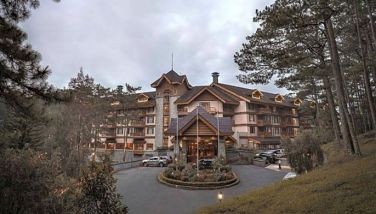20th century Pinoy most wanton forest destroyer
January 2, 2005 | 12:00am
More than half a century ago, Tandoc in Camarines Sur was a dense virgin forest.
The idyllic place seemed a fairyland to internationally known American botanist David Fairchild when he set foot on it in 1939. Here, he collected some of the rare plant species he had gathered from various parts of the world and introduced them to America.
Fairchild later chronicled his 1939 expedition in his work titled "Garden Islands of the Great East — Collecting Seeds from the Philippines and Netherlands India in the Junk ‘Cheng Ho,’" which was published in 1945.
The American scientist described Tandoc as "a wonderful dipterocarp forest." "Here we collected the beautiful Orania palindan... a fine fan palm Livestona robinsoniana... We got also a striking aroid with a very large white spathe... and a strikingly beautiful Sararanga whose flower clusters were two and a half feet long and looked like gigantic bunches of little yellow grapes... A tree of the Nauclea orientalis with beautiful white flowers borne in pin cushion-like heads and beautiful broad leaves," he wrote.
A quarter of a century after Fairchild’s sojourn to Tandoc, the place was nothing but "a desolate cogonal land with a rotting pier where logs used to be shipped out for export."
Vincenta Escobar, who visited Tandoc in 1965, wrote in a nostalgic piece published years later in a Manila daily:
"The fairyland description of the place in 1939, in contrast to my own desolate memory of the area in 1965, is to my mind the best argument to prove that logging operations can never restore the ecology of a forest and that reforestation in our country is a myth. It is a lie made more blatant by the fact that it is really never enforced even if in every logging contract it is stipulated that reforestation work will be undertaken by the concessionaire — that for every tree that the logger cuts, the logger is obligated to plant an equivalent tree seedling. Can someone please point out a reforested virgin forest?"
Indeed, Tandoc, to those who had seen its pristine sylvan beauty, is now but a memory. Just like the vast natural resources that once characterized the Philippine countryside — lush tropical growth than mantled mountains, sparkling and roaring waters of rivers and streams, verdant hills, green meadows, picturesque valleys, serene lakes and shimmering bays.
A broad-brush picture of the Philippines today shows a vast environmental wasteland — bald mountains, dead or dying rivers, brown treeless hills, desolate valleys and plains, and heavily polluted and silted lakes and bays.
And the tragic thing is that as these life support systems lie dead or dying following their wanton exploitation or destruction, the country’s population continues to grow at a still fast rate (2.34 percent).
In the 1930s when Fairchild was here, there were only about 17 million Filipinos. By the mid-1990s, the population had doubled to 34 million. Today, there are about 85 million Filipinos.
With the continued degradation of the environment set against the grim backdrop of an exploiting population, one wonders how well the Philippines would fare in its "race against time."
It has been projected that at the rate the Philippines is ravaging its natural resources, it would be the first Southeast Asian country to lose its forests within the first half of the 21st century.
Once upon a time, Philippine forests were a sight — a paradise — to behold.
This upland ecosystem harbored about 3,500 species of indigenous trees, 8,120 species of flowering plants, 950 species and subspecies of birds, 240 to 250 species and subspecies of reptiles, and 640 species of mosses.
There were about 3,800 species of plants endemic to the Philippine archipelago and not found anywhere else in the world.
Scientists and researchers have lamented that a good number of these flora and fauna have disappeared or are headed for extinction because of the unabated destruction of mountains attributed to logging, swidden (kaingin) farming, forest fires, tree pests and diseases, and mining operations, which usually hasten soil erosion and clog rivers with mine tailings.
Records show that in 1575, at the early period of the Spanish colonization of the Philippines, forests covered 27.5 million hectares or 92 percent of the country’s total land area of 30 million hectares.
By 1920 or nearly three-and-a-half centuries later, there were still 18.7 million hectares of natural forests. This shrank to 17 million hectares in the mid-1930s.
What remained as of the late 1990s were only 5.4 million hectares, a big chunk of which were non-productive, and less than a million hectares of virgin forests. Today, forest-covered areas are much less.
At the height of the logging industry in the 1960s, the average annual deforestation rate was a high of 300,000 hectares per year. In the 1980s, it went down to 150,000 hectares per year and further to 100,000 hectares per year in the 1990s.
Thus, the 20th century Filipino has been the most wanton destroyer of the country’s forests. And today’s (early 21st century) rapacious and greedy loggers — legal and illegal — and survivalist mountain dwellers are bent on wiping out what is left of the country’s natural resources.
Records show that as early as the 1990s, the Philippines has been importing logs to feed its construction, furniture and wood-related industries, in great contrast to the years when the country was an exporter of a substantial volume of logs.
"There is now a critical shortage of raw materials (logs)," an official of a wood-processing firm admitted at a conference on forest products’ marketing held a few years back in Los Baños, Laguna.
Contributing to the massive destruction of forests during the past four decades have been the tremendous pressure from an increasing population in search of land to till and in need of wood, over-exploitation of timber resources, and inadequate forest development and conservation efforts.
As of 1990, according to the Department of Environment and Natural Resources (DENR), there were already 18.3 million people in the uplands. Of this number, 8.5 million were forest dwellers who belonged to the country’s "poorest of the poor."
The latest figure gathered by this writer was 22 million upland dwellers.
The number of people occupying forested areas is projected to swell to 27 million by 2005, soaring to 43.5 million in 2025 when the density level would reach a high of 339 people per square kilometer.
An environment expert, Dr. Ma. Concepcion Cruz, once cited two major consequences if these trends would continue.
First, to meet the migrants’ food needs, more forestlands will be cleared for farming. Second, as upland agriculture accelerates, soil erosion, flooding, sedimentation and siltation will occur, affecting the plains. Upland migrants, possessing little cultural adaptation to mountain environments, will transform the forests into degraded croplands.
In fairness to the government, it has been adopting measures to regulate the logging industry and manage forest resources.
But as it has turned out so far, the country’s forestlands have been virtually littered with the blueprints of grandiose forest protection and conservation programs that failed, and forestry laws that were never or could not be implemented.
In sum, it is best that Filipinos of today be reminded of the pastoral letter of the Catholic Bishops’ Conference of the Philippines circulated in January 1988. Titled "What is Happening to Our Beautiful Land," the letter stated in part:
"It is late in the day and many changes have already been done. No one can pinpoint the precise moment when these damages become irreversible and the collapse of this living world become imminent. Even now there are signs of stress in every corner of our land.
"As we look at what is happening and think of the horrendous consequences for the land and the people, we would do well to remember that God, who created this beautiful land, will hold us responsible for plundering it and leaving it desolate."
The idyllic place seemed a fairyland to internationally known American botanist David Fairchild when he set foot on it in 1939. Here, he collected some of the rare plant species he had gathered from various parts of the world and introduced them to America.
Fairchild later chronicled his 1939 expedition in his work titled "Garden Islands of the Great East — Collecting Seeds from the Philippines and Netherlands India in the Junk ‘Cheng Ho,’" which was published in 1945.
The American scientist described Tandoc as "a wonderful dipterocarp forest." "Here we collected the beautiful Orania palindan... a fine fan palm Livestona robinsoniana... We got also a striking aroid with a very large white spathe... and a strikingly beautiful Sararanga whose flower clusters were two and a half feet long and looked like gigantic bunches of little yellow grapes... A tree of the Nauclea orientalis with beautiful white flowers borne in pin cushion-like heads and beautiful broad leaves," he wrote.
A quarter of a century after Fairchild’s sojourn to Tandoc, the place was nothing but "a desolate cogonal land with a rotting pier where logs used to be shipped out for export."
Vincenta Escobar, who visited Tandoc in 1965, wrote in a nostalgic piece published years later in a Manila daily:
"The fairyland description of the place in 1939, in contrast to my own desolate memory of the area in 1965, is to my mind the best argument to prove that logging operations can never restore the ecology of a forest and that reforestation in our country is a myth. It is a lie made more blatant by the fact that it is really never enforced even if in every logging contract it is stipulated that reforestation work will be undertaken by the concessionaire — that for every tree that the logger cuts, the logger is obligated to plant an equivalent tree seedling. Can someone please point out a reforested virgin forest?"
A broad-brush picture of the Philippines today shows a vast environmental wasteland — bald mountains, dead or dying rivers, brown treeless hills, desolate valleys and plains, and heavily polluted and silted lakes and bays.
And the tragic thing is that as these life support systems lie dead or dying following their wanton exploitation or destruction, the country’s population continues to grow at a still fast rate (2.34 percent).
In the 1930s when Fairchild was here, there were only about 17 million Filipinos. By the mid-1990s, the population had doubled to 34 million. Today, there are about 85 million Filipinos.
With the continued degradation of the environment set against the grim backdrop of an exploiting population, one wonders how well the Philippines would fare in its "race against time."
It has been projected that at the rate the Philippines is ravaging its natural resources, it would be the first Southeast Asian country to lose its forests within the first half of the 21st century.
Once upon a time, Philippine forests were a sight — a paradise — to behold.
This upland ecosystem harbored about 3,500 species of indigenous trees, 8,120 species of flowering plants, 950 species and subspecies of birds, 240 to 250 species and subspecies of reptiles, and 640 species of mosses.
There were about 3,800 species of plants endemic to the Philippine archipelago and not found anywhere else in the world.
Scientists and researchers have lamented that a good number of these flora and fauna have disappeared or are headed for extinction because of the unabated destruction of mountains attributed to logging, swidden (kaingin) farming, forest fires, tree pests and diseases, and mining operations, which usually hasten soil erosion and clog rivers with mine tailings.
Records show that in 1575, at the early period of the Spanish colonization of the Philippines, forests covered 27.5 million hectares or 92 percent of the country’s total land area of 30 million hectares.
By 1920 or nearly three-and-a-half centuries later, there were still 18.7 million hectares of natural forests. This shrank to 17 million hectares in the mid-1930s.
What remained as of the late 1990s were only 5.4 million hectares, a big chunk of which were non-productive, and less than a million hectares of virgin forests. Today, forest-covered areas are much less.
Thus, the 20th century Filipino has been the most wanton destroyer of the country’s forests. And today’s (early 21st century) rapacious and greedy loggers — legal and illegal — and survivalist mountain dwellers are bent on wiping out what is left of the country’s natural resources.
Records show that as early as the 1990s, the Philippines has been importing logs to feed its construction, furniture and wood-related industries, in great contrast to the years when the country was an exporter of a substantial volume of logs.
"There is now a critical shortage of raw materials (logs)," an official of a wood-processing firm admitted at a conference on forest products’ marketing held a few years back in Los Baños, Laguna.
Contributing to the massive destruction of forests during the past four decades have been the tremendous pressure from an increasing population in search of land to till and in need of wood, over-exploitation of timber resources, and inadequate forest development and conservation efforts.
As of 1990, according to the Department of Environment and Natural Resources (DENR), there were already 18.3 million people in the uplands. Of this number, 8.5 million were forest dwellers who belonged to the country’s "poorest of the poor."
The latest figure gathered by this writer was 22 million upland dwellers.
The number of people occupying forested areas is projected to swell to 27 million by 2005, soaring to 43.5 million in 2025 when the density level would reach a high of 339 people per square kilometer.
An environment expert, Dr. Ma. Concepcion Cruz, once cited two major consequences if these trends would continue.
First, to meet the migrants’ food needs, more forestlands will be cleared for farming. Second, as upland agriculture accelerates, soil erosion, flooding, sedimentation and siltation will occur, affecting the plains. Upland migrants, possessing little cultural adaptation to mountain environments, will transform the forests into degraded croplands.
In fairness to the government, it has been adopting measures to regulate the logging industry and manage forest resources.
But as it has turned out so far, the country’s forestlands have been virtually littered with the blueprints of grandiose forest protection and conservation programs that failed, and forestry laws that were never or could not be implemented.
In sum, it is best that Filipinos of today be reminded of the pastoral letter of the Catholic Bishops’ Conference of the Philippines circulated in January 1988. Titled "What is Happening to Our Beautiful Land," the letter stated in part:
"It is late in the day and many changes have already been done. No one can pinpoint the precise moment when these damages become irreversible and the collapse of this living world become imminent. Even now there are signs of stress in every corner of our land.
"As we look at what is happening and think of the horrendous consequences for the land and the people, we would do well to remember that God, who created this beautiful land, will hold us responsible for plundering it and leaving it desolate."
BrandSpace Articles
<
>
- Latest
- Trending
Trending
Latest
Trending
Latest
Recommended































